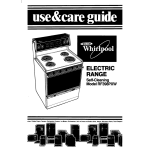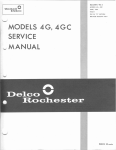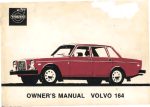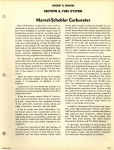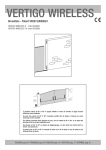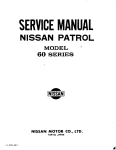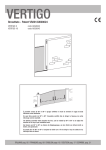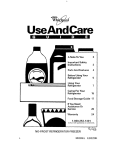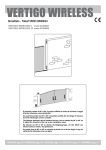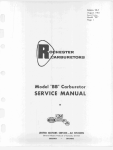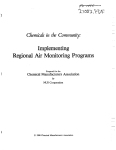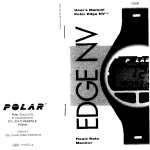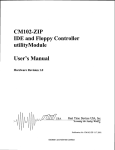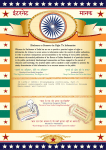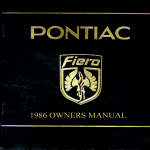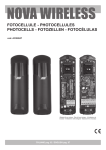Download MARVEL-SCHEBLER - The Old Car Manual Project
Transcript
for MARVEL-SCHEBLER TRACTOR and INDUSTRIAL CARBURETERS MODELS DLTX & TSX MARVEL-SCHEBLER PRODUCTS DIV. BORG-WARNER CORPORATION DECATUR, ILL., U S.A. FORM NO ME 184 Marvel-Schebler Products Division, Borg -Warner Corporation, Decatur, Illinois, U. S. A. Principle of Operation Marvel-Schebler C a r b u r e t e r s a r e u s e d on thousands of tractor a n d industrial engines and have been designed to provide many years of trouble-free service, however, as in t h e case of all mechanical devices, they do in time require ;,roper service a n d repairs. An understanding of their construction a n d how they operate a s well as a n understanding of their function with respect to t h e engine will not only avoid many false leads on t h e p a r t of t h e service m a n in diagnosing so-called carbureter complaints but will create customer satisfaction a n d a profitable business f o r t h e progressive service shop. To understand a carbureter i t is necessary to realize t h a t there is only one thing t h a t a carbureter is designed t o do a n d t h a t is t o mix fuel and a i r in t h e proper proportion so t h a t t h e mixture will burn efficiently in an engine. It is t h e function of t h e engine to convert this mixture into power. There a r e three major factors in an engine which control t h e change of fuel a n d a i r into power: 1-Compression. 2-Ignition. 3-Carburetion. Carburetion has been listed last because it is absolutely necessary f o r t h e engine to have good compression a n d good ignition before it can have good carburetion. When the average person thinks of "carburetion" they immediately think of t h e carbureter as a unit. Carburetion is t h e combined function of the carbureter, manifold, valves, piston and rings, combustion chamber, a n d cam shaft. It can be readily seen t h a t "carburetion" is a f a r deeper subject than consideration of t h e carbureter alone, and expecting t h e carhureter to cure faulty ignition, compression, valves, etc. will only result in wasted time a n d effort on t h e p a r t of t h e service m a n a n d added expense to t h e customer. It must be remembered t h a t t h e function of the carbureter does not extend beyond deliver~ n p t h e proper mixture of fuel and a i r to t h e manifold a n d t h e other factors which effect power a n d economy cannot be changed o r corrected by t h e carbureter. Inability t o understand all t h e factors t h a t effect engine operation is t h e reason many service mechanics change from factory standards a n d attempt to improve on t h e engine set-up by their own methods or "standards". All t h a t any service mechanic should ever try to do is to make t h e particular engine h e is working on as good as t h e manufacturer intended i t to be, b u t he can m a k e i t a lot worse. F a r too many engines a r e running below their standard of performance in service today. F o r the carbureter to accomplish its function it must be able to vary t h e mixture strength dependent upon t h e engine demands. It must supply a mixture strength t h a t urill allow t h e engine to give maximum horsepower, whenever t h e throttle is fully opened, while a t p a r t throttle conditions it must lean out t h e mixture so that maximum economy can be obtained. In addition it must have flexibility throughout the entire range of operating speeds, from idle and p a r t throttle to full power wide open throttle position. The carbureter must also have a n accelerating "well" with enough fuel capacity to start handling sudden maximum loads. In other words the carbureter not only varies t h e volume of fuel and a i r t h a t enters t h e engine but also varies t h e amount of fuel t h a t goes in with a given amount of air, h order to produce t h e proper mixture proportion for any condition under which t h e engine is operating a t any time. In order to understand t h e function a n d operation of t h e Marvel-Schebler Tractor and Industrial Carbureters i t is well to consider t h e systems t h a t make up each carbureter. These systems a r e : The F l o a t System, T h e Idle System, The Power Fuel Feed System, The Back Suction Economizer System, a n d The Choke System. A thorough knowledge of each system will help t h e service mechanic to quickly locate a n d correct legitimate carbureter complaints as well a s t o inspect, repair, a n d put back to standard a n y carbureter t h a t requires a n overhaul. Marvel-Schebler Products Division, Borg-Warner Corporation, Decatur, Illinois, U. S. A. Float System FLOAT VALVE FLOAT VALVE-3 FUEL BOWL-! The float system controls t h e level a n d supply of gasoline in the fuel bowl throughout t h e operating range of t h e engine. When t h e fuel bowl (1) is empty t h e float and lever (2) and float valve ( 3 ) drop a n d fuel under pressure from t h e fuel pump (or gravity feed) is forced through t h e float valve seat (4) around t h e float valve ( 3 ) a n d into t h e fuel bowl (1). As t h e fuel in t h e bowl approaches the correct operating level i t raises t h e float a n d lever (2) with enough force t o raise t h e float valve and cut off t h e flow of fuel into t h e bowl. As fuel feeds through t h e carbureter jets into t h e engine t h e fuel level (5) drops, allowing additional fuel to enter t h e fuel bowl. Under actual operating conditions t h e fuel level (5) and float and lever (2) automatically position themselves so t h a t t h e inward flow of gasoline to t h e carbureter is equal to t h e outward flow of gasoline t o t h e engine. As can readilv be seen t h e float system under the most favorable of operating conditions is subjected to a certain amount of wear. Under severe conditions or conditions t h a t result in excessive vibrations being transmitted to the carbureter, float valve a n d float valve seat wear is accelerated. It should be an established policy t h a t whenever t h e carbureter is disassembled f o r whatever c a u s e t h e service m a n make following checks: 1. Examine float valve for any signs of wear. If i t is not absolutely true or is grooved a n d hasn't a perfect taper, a new float valve and also a n e w f l o a t valve s e a t must be used. These float valves a n d seats a r e supplied in matched sets and a r e tested a t t h e factory for leaks. Always use a new float valve s e a t g a s k e t t o make sure of a perfect seal. 2. Examine float for any signs of failure. To test metal float submerge float in pan of hot water and if a i r bubbles a r e observed replace with new float. Examine cork float f o r bare places or cracks in coating. If either a r e found, or if float shows evidence of having been soggy, replace with new one. (Do not attempt to recover float with shellac or varnish.) 3. Set float height to t h e proper specification for the particular model carbureter being serviced. Make certain t h a t t h e entire assembly works f r e e a n d t h a t there is no binding. 4. Wash fuel strainer assembly in gasoline and clean screen with air under pressure. If the screen, or t h e threads on t h e strainer a r e not in good condition, install a new assembly. W h e n re-installing fuel strainer assembly always use a new strainer gasket if a gasket is used t o obtain a seal. I t has been proven, with few exceptions, t h a t with a float system in good order, carbureter flooding only occurs when dirt or foreign matter becomes lodged between the float valve ( 3 ) a n d float valve seat ( 4 ) . Marvel-khebler Products Division, Borg-Warner Corporation, Decatur, Illinois, U. S.A. The Idle System PRIMARY IDLE ORIFICE-7 IDLE NEEDLE-13 SECONDARY IDLE ORIFICE-8 IDLE ADJUSTING NEEDLE SEAT-I2 t h e throttle valve ( 6 ) since this valve must be slightly open to permit t h e engine to idle. The resultant mixt u r e is correct f o r operating engine a t idle speed, provided t h e idle adjusting needle (13) is prop- erly adjusted. As t h e throttle valve ( 6 ) is slowly opened from t h e slow idle position i t gradually subjects t h e seconda r y idle orifice (8) t o int a k e manifold vacuum, a n d t h e secondary idle orifice ( 8 ) no longer bleeds air t o t h e idle fuel passage (10) but feeds a n additional quantity of fuel into t h e engine. This is proper since t h e throttle valve is now open wider a n d will admit a greater amount of a i r to blend with this additional fuel to maintain the correct proportions of fuel a n d air for the engine. FUEL BOWL CHAMBER-9 The idle system controls t h e Aow of fuel a t idle speed and a t slow speeds until t h e throttle is opened wide enough t o allow t h e power fuel feed system t o function. When t h e throttle valve (6) is in t h e idle position the edge of t h e valve is between t h e primary idle orifice (7) and the idle orifice ( 8 ) . With t h e valve in this position t h e air pressure (manifold vacuum) a t t h e primary idle orifice (7) is lower than t h e a i r pressure in t h e fuel bowl chamber (9) a n d fuel is forced from the fuel bowl (1) into t h e idle fuel passage (10). As t h e fuel travels through t h e idle fuel passage (10) i t passes through t h e metering orifice of the idle jet (11) to t h e point where it is combined with a i r entering through the idle adjusting needle seat ( 1 2 ) . The mixing of air with gasoline helps to atomize t h e fuel a n d this Process is repeated a t t h e secondary idle orifice ( 8 ) a s t h e fuel travels through t h e idle fuel passage (10). As this rich mixture of fuel and air ernergesfrom the primary idle orifice (7) it is reduced to caruect proportions by t h e a i r which passes around As t h e throttle valve ( 6 ) is opened still wider, t h e idle fuel delivery begins to f a d e out, howcver, t h e throttle valve a t this point is f a r enough open for t h e power fuel f e e d system t o begin functioning. The idle system a s described above is t h e most positive a n d satisfactory of idle systems, as it is working under very high suction a n d t h e mixture flows through t h e small passages a n d orifices a t very high velocities. It is necessary to bear in mind, however, that there are times these small holes may plugged \vith particles of dirt or foreign matterand will clean. ing. A t such times t h e passages, jets, and small drilled holes should only be cleaned with a cleaning fluid such as gasoline and air under pressure. Never use drills or wires as a change in size of these small openings will change t h e entire calibration of t h e carbureter. Page 3 Marvel-Schebler Products Division, Borg-Warner Corporation, Decatur, Illinois, U.S. A. Power Fuel Feed System THROTTLE VALVE-6 NOZZLE AIR VENT-21 FUEL BOWL CHAMBER-9 POWER JET-20 POWER ADJUSTING NEEDLE-18 With the throttle valve (6) in slow or just off slow idle position, fuel rises up through the nozzle (14) and out the nozzle air bleeds (15) to fill the accelerating well (16) to approximately the height of the fuel level in the fuel bowl ( 1 ) . As the engine speed is increased from the slow idle position the air flow through the venturi (17) is gradually increased, and, as the idle system begins to diminish,the velocity through the venturi (17) is high enough to create a pressure a t the tip of the nozzle (14) slightly less than the pressure in the fuel howl chamber (9) and the accelerating well (16). Fuel, therefore, feeds from the fuel bowl (1) through the opening between the power (load) adjusting needle (18) and the power adjusting needle seat (19), through the power jet (20) and out the nozzle (14) to be discharged into the air stream a t the Parre 4 venturi (17). At the same time, the fuel that is stored in t h e accelerating well (16) is also forced through the nozzle air bleeds (15) into the nozzle (14). But, because the size of the power jet (20) and the position of the power adjusting needle (18) restrict the amount of fuel which can enter the nozzle (14), the fuel in the accelerating well (16) will soon be exhausted and a i r will then e n t e r through t h e nozzle air bleeds (15) to mix with the fuel passing through the nozzle (14). The amount of air that can enter into the nozzle (14) is limitcd by the size of the nozzle air vent (21). The result of air bleeding into the nozzle (14) is, to help atomize or break ua the fuel into finer particles, to regulate the quantity and the rate of discharge of the fuel fed from the accelerating well ( I F ) , during acceleration, and to inovide the correct mixture proportions for full throttle operation. As the throttle valve is opened toward the wide open position the velocity through the renturi (17) continues to increase, lowering the air Pressure a t the nozzle (14) and resulting in additional fuel being supplied to the engine as the speed is increased. When the throttle valve (6) is opened suddenly from slow or just off slow idle position, the fuel stored in t h e accelerating well (16) is forced out through the nozzle air bleeds (15) very rapidly and serves to provide the extra richness required by the engine to meet the sudden load. When the throttle valve (6) is closed fuel again fills the accelerating well (16), ready for the next acceleration. Marvel-Schebler Products Division, Borg -Warner Corporation, Decatur, Illinois, U.S. A. Back Suction Economizer System ECONOMIZER ORIFICE-24 ECONOMIZER JET-23 FUEL BOWL CHAMBER-9 The amount of fuel supplied to a n engine is controlled by the size of the power jet, the sition of the power adjusting needle, and the difference in air pressure between the fuel bowl chamber and the veuturi. However, in many engines the mixture must be leaned out tionally during part throttle operation to obtain maximum economy. T~ provide this leaner mixture Marvel-Schebler Tractor and Industrial Carhureters make use of the "Back Suction Economizer System, With this method of metering fuel, the air pressure in the fuel bowl chamber is regulated and controlled according to load conditions by a combination of bowl vent and economizer passages communicating with the bore the carbureter. Through regulations of the air pressure in the fuel bow' chamber the the carbureter can be controlled to provide the prope r mixture proportions for the engine. All the air that enters the fuel bowl chamber (I)) must first pass through the air cleaner and the howl vent (22). The size of the bowl vent (22) controls or limits the amount of air that can enter the fuel bowl chamber (9). The amount of air that is drawn out of the fuel bowl chamber (9) is controlled by the size of the economizer jet (231, the economizer orifice (24) and the position of the throttle valve (6) as its position determines the manifold vacuum or suction on the economizer orifice (24). As the throttle valve ( 6 ) is opened from the fast idle position the economizer orifice (24) is gradually exposed to manifold suction, and air flows from the fuel bowl chamber (I)), through the economizer jet (23) and out the economizer orifice (24). This air must be replaced by air entering through the bowl vent (22) but as the size of the bowl vent (22) restricts the amount of air that can enter, the resultant pressure in the fuel bowl chamber (9) will be lowered, reducing the difference in air pressure between the nozzle (14) and the fuel bowl chamber ( 9 ) . The flow of fuel will therefore be retarded so t h a t the exact economy mixture ratio will be delivered to the engine a t this particular throttle opening. Opening the throttle valve (6) further exposes the entire economizer orifice (24) to manifold suction, resulting in additional air being removed from the fuel bowl chamber ( g ) , again leaning out the mixture ratio t o t h e correct proportions for this new throttle position. After the economizer orifice (24) is fully exposed to manifold suction the amount of air that is drawn out of the fuel bowl chamber (9) is controlled by the manifold vacuum or suction a t any given throttle valve (6) position and as this suction decreases as t h e throttle approaches wide open position, less air is drawn out of the fuel bowl chamber and additional fuel flows to the engine to provide the extra richness required for operation a t heavy loads where maximum horsepower is necessary. The "'Back Suction Economizer System" assures the proper metering of fuel to the engine throughout the service life of the carbureter as there are no moving parts to wear out or adjustments to get out of order. ~t is essential, how. ever, t h a t the system remain free of dirt and foreign matter because any foreign substance in the system will restrict the flow of air thereby creating improper pressures in the fuel bowl chamber and resulting improper fuel delivery to the engine. Page 5 Marvel-Schebler Products Division, Borg -Warner Corporation, Decatur, Illinois, U. S. A. Choke System The choke system is used during cold starting and the warm-up period. Under these cold conditions it is necessary to supply an additional rich mixture of fuel and air, as only the "light ends" or more volatile portions of the fuel will vaporize with the manifold and air ternperatures a t these cold conditions. Consequently it is necessary that a large quantity of fuel be available so that there will be enough "light ends," to combine with the air to form a combustible mixture for starting the engine. The function of the choke valve ( 2 5 ) is to restrict the amount of air t h a t can enter the carbureter and to increase the suction on the nozzle (14) so that additional fuel will be drawn into the manifold. As soon a s the engine fires and runs the rich mixture must be rapidly reduced to prevent stalling. This change in mixture is accomplished by the operator positioning the choke valve to provide the proper mixture. However, a few degrees movement of the choke valve (25) will make a big change in the mixture strength and to help reduce the sensitivity of the choke Page 6 valve (25) position use is made of a spring loaded relief valve (26) in many applications. This valve opens automatically with engine speed and load and eliminates a great deal of manipulation of the choke on the part of the operator. When the engine has obtained normal operating temperature the choke valve (25) must be fully opened to assure maximum power and economy. In addition, extended use of the choke results in more gasoline being supplied to the engine than can be burned. A large percentage of the unburned gasoline is lost through the exhaust system. The remainder of the raw gasoline is forced between the pistons and cylinder walls, washing away the protective oil film and increasing engine wear, and enters the crankcase where it dilutes the engine oil. Any adjustments that are necessary on the earbureter should never be attempted until the engine has obtained its normal operating temperature and the choke valve (25) has been placed in the wide open position. Marvel-Scbebler Products Division, Borg-Warner Corporation, Decatur, Illinois, -U.S. A. Model TSX Carbureter IDLE ADJUSTING NEEDLE 'FUEL' IDLE ADJUSTING NEEDLE ! A I R ' POWER JET BOWL DRAIN ADJUSTING NEEDLE Fis. I-Idle and Power Foe1 Feed The Marvel-Schebler M o d e l T S X Carbureter is manufactured in three S A E. nominal sizes: 74, inch, 1 inch, and 11% inch. In addition to these variations in size, there a r e also variations necessitated by t h e specific requirement of t h e engines on which t h e carbureters a r e used. Many engines, f o r instance, require special throttle and choke operating levers, and for purpose of calibration, they may have different size jets, nozzles, venturii, etc. F o r this reason when ordering parts, refer to t h e individual carbureter service parts list for t h e engine on which t h e carbureter is installed. The Model TSX Carburetcr consists of only two major castings: 1. The throttle body casting which forms t h e cover f o r t h e fuel bowl. 2. T h e fuel bowl casting which contains the a i r inlet. Cast iron material is used for ruggedness. I t will be noticed (Figure 1) t h a t all passages, whenever possible, a r e drilled from t h e top face of t h e fuel bowl casting t o prevent any fuel leaks to t h e outside of t h e carbureter, because uf shrunken gaskets or defec- tive hole plugs, a n d also to prevent vapor lock or "percolation" of t h e fuel when t h e carbureter is o p e r a t e d u n d e r extremely hot conditions, resulting in hard startiqg or erratic engine operation. The Model TSX carbureter is completely sealed against dust or dirt. All air entering t h e fuel bowl of the carbureter must first pass through the air cleaner. The throttle shaft bearings and choke shaft bearings a r e sealed to eliminate dust and dirt entering a t these points. The back suction economizer system (Figure 2 ) is provided with a r e m o v a b l e economizer jet. The size of this jet has been carefullv established by engheerSystems in^ tests to vrovide t h e exact fuel requirements f o r maximum economy a t p a r t throttle operation. Always use t h e economizer jet specified in the individual carbureter service parts list t o assure proper engine operation. On some carhuVOMIZER JET ECONOMIZER Fix. 2-Back Suetien Economizer System Page 7 Marvel-Schebler Products Division, Borg-Warner Corpuration, Decatur, Illinois, U. S. A. Model TSX Carbureter CHOKE VALVE GASOLINE DRAIN STRAINER Fig. 3-Float and Choke Systems reter models t h e proper fuel requirements a r e established without t h e use of a n economizer jet and t h e fixed economizer orifice machined in t h e carbureter throttle body regulates t h e fuel supplied to t h e engine. In addition, there a r e engine and carbureter combinations t h a t d o not require the back suction economizer system. In these carbureters t h e economizer orifice h a s not been machined in t h e throttle body casting. To provide additional economy, in addition to the back suction economizer system, some carbureters a r e provided with t w o adjusting needles, the low speed or idle adjusting needle, and the power or load adjusting needle. However, the power adjusting needle is not always required and f o r applications of this nature t h e fixed jet type carbureter is used in which t h e power jet controls t h e amount of fuel t h a t is supplied t o the engine. There a r e two variations in carbureters having t h e power adjusting needle, commonly called the adjustable jet type carbureter. In Figure 1 is shown these two arrangements. The adjustment of either type is accomplished in the same manner. A large percentage of the Model TSX Carbureters a r e l~rovidedwith a n idle adjusting needle which alters t h e fuel and air proportions of t h e mixture which enters ;llz carbureter bore from the idle passage (Figure 1).This is known as an a i r adjusting idle needle. The upper inset in Figure 1 shows a n idle adjusting needle which alters t h e amount of fuel a n d a i r mixture which enters t h e carbureter bore from t h e idle passage. This is commonly known as a fuel adjusting idle needle. It is important to ren1ernbt.r in setting t h e idle mixture the air adjusting idle needle must be turned in, or clockwise, to enrich t h e idle mixture, a n d t h e fuel adjusting idle needle must be turned out, o r counter-clockwise to enrich t h e idle mixture. A dual float mechanism (Figure 3 ) is used in a fuel bowl t h a t almost completely surrounds t h e nozzle. This design and construction is such t h a t t h e tractor, or engine, can be operated a t any angle up t o 45 degrees without seriously affecting t h e fuel a n d a i r ratio a n d without flooding because t h e mean level a t t h e nozzle tin is nractitally constant a t any angle of bperation. Some carbureters a r e equipped with a springloaded governor control lever to permit manual closing of t h e throttle to an idle position for engines equipped with certain type governors. An example of this type lever is shown in Figure 4, however, there a r e other variations of this type dependent upon the particular application. While there a r e many variations produced by combining the different types and sizes into a specific application, all Model TSX carbureters incorporate t h e same engineering principles and a r e alike from a functional standpoint. Fig. 4-Spring-Loaded Governor Lever Marvel-Schebler Products Division, Borg-Warner Corporation, Decatur, Illinois, U. S. A. Service Instructions for Model TSX Carbureters Type A-Fixed Jet Type B-Adjustable Jet Type C-Adjustable Jet The following procedure f o r service of all Model TSX Carbureters is for a complete overhaul. After removing carbureter from engine wash thoroughly with cleaning fluid such as gasoline to permit examination of external parts for damage. For type carbureter being serviced see illustrations above. Instructions apply to all types unless specified otherwise. Remove Power Adjusting Needle A..tmbly. Type B. Remove Economizer Jet. TOTE. S o t reuulwrl i n ;,I1 carbureters. Check service parts list o r repair kit of carbureter being serviced. 2- 6- Remove Bowl Cover Screws and Loek Washer. Remose Idle J e t Separate Castings. ,- ! " I '.,::%:*, 1 . L NOTE. Not required in all carbureters. Cheek service parts list o r repair kit of carbureter being serviced. 3- 7- Remove Float Valve, Bowl Casket, a n d Venturi. Removins Idle Adjusting Needle and Spring If Valve is grooved or damaged, replace Valve and Float V a l w Seat. Replace with new Needle if grooved o r damaged 4- Remove Float Valve Seat a n d Caeket. Remove Throttle Valve Screws. Valve, and Throttle Shaft a n d Lever Assembly Replace with new shaft and lever assembly if excessive looseness between shaft and throttle body. 1 -1 I Marvel-Schebler Products Division, Borg-Warner Corporation, Decatur, Illinois, U. S. A. 14- Remove Throttle Shaft Packing Retainer and Packing Force out Retainer with small screwdriver or punch 10- Remove Retainer Plug and Gasoline Drain Strainer. Strainer can only be replaced an earbureters having a curled hair or felt t y p e s t r a i n e r . Only replace when impassible to clean with gasoline and compressed air. P o r o u s metal type strainer cann o t be replaced. Clean only. Remove Main Nozzle and Gasket. Type A Type B 15Remove Choke Valve Screws. Valve, Choke Shaft & Lever Assembly, Choke Return Spring, and Choke Bracket. 11- 16- Remove Power Jet. Remove Choke Shaft Packing Retrine. and Packing. Force out retainer with small serewdriver o r punch. "ASSEMBLE 12- 17- Remove Power Adjusting Needle As.cmhly. In.t.11 Throttle Shaft Packing and Retainer. Type C Assemble n e w r e t a i n e r and packing on throtpe shaft. Insert shaft in carbureter and tap lightly until retainer is flush with casting face. Carbureters not having. adjustable needle remove power jet. 1 6 Remove Main Nozzle and Gasket. Install Throttle Valse and. Screw*. Type C Install valve with angle identification mark facing. flange face of carbureter. Tap valve lightly t o tent e r in throttle bore. Tighten screws securely. "Before assembling carbureter, clean castings, channels, and parts with carbureter cleaning fluid and air under pressure. Make certain all small holes and channels are open and free from carbon and dirt. Do not use wire or small drills to clean out small holes as a slight change in size of these holes will affect the carbureter operation. To assure a successful overhaul always replace all worn or damaged parts and any parts that are questionable. Always use all new gaskets. Marvel-Schebler Products Division, Borg-Warner Corporation, Decatur, Illinois, U. S. A. 19- 25- Install Economizer Jet. 1n.tall Choke S h a f t Packinn - Retainer and Packing. , Install retainer a s shown in illustrations below. Note: On some carbureter models the packing is retained by choke bracket in place of packing retainer. i . A:..., Install Idle Jet. On c a r h u r e t e r s counterbored ?&" t o &" deep install r e t a i n e r wlth CUD facing t o w a r d s e a s t m i . Tap lightly u n t ~ flush l with casting face. 21- 1n.tall Idle Adjusting Needle and Spring. . ,* ' I=. I Set annroximatelv one .. turn from seat f o r preliminam setting. On c a r b u l e t e r s counterbored &" t o % " deen ~ n stall r e t a i n e r withLcur, 1 facing away from castink. Tap lightly until flush with casting face. 22- 26- Install Float Valve Seat and Gasket. Install Choke Bracket, Choke Return Spring. Choke Shaft and Lever A*sembly, Valve. and Screws. Use new Float Valve and Seat Assembly. 1 f I Center valve in casting before tiehtening screws. 13Assemble Bowl Cover Gasket and Ventvri in Casting. Install float valve. Install Float and Lever Assembly and Float Lever Pin. Set floats % " from gasket face t o nearest edge of float, keeping edge of float parallel with gasket. Adjust by using bending tool #M-8. Install Power Jet. Type A Type B Install Main Nozzle and Gasket. Type A Type B Use new gasket. I I j I I I Marvel-Schebler Products Division, Borg-Warner Corporation, Decatur, Illinois, U. S. A. 29- Install Main Nozzle and Gasket. Type C Use new gasket. Assemble Castings. Invert throttle body and lower fuel howl over floats taking $ r e c a u t i o n t h a t ventnri guides bodies into position. 30- 33- Install Power Adjusting Needle Assembly. Install Bowl Cover Screw. a n d Lock Washers. Type C Use new gasket. Tighten screws madually until all a r e tight. Set approximately one t u r n from seat f o r preliminary setting. 31- Install Gasoline Drain Strainer & Retainer Plug. Install Power Adjusting Needle Assembly. Stake retainer plug in place with center punch to insure secure locking. Type A Set approximately one t u r n from seat f o r preliminary setting. Adjustment Instructions PRELIMINARY ADJUSTMENTS 'IDLE Set throttle stop screw so t h a t throttle valve is open sliahtly. Make certain that fuel supply t o earhureter is open. Close choke valve. S t a r t engine and partially release choke. After the engine has been r u n sufficiently t o bring up to operating temperature throughout, see t h a t choke is returned t o wide open position. To richen the idle mixture t u r n the idle adjusting needle t o the right o r clockwise. LOW SPEED OR IDLE ADJUSTMENT Set throttle o r governor control lever in slow idle position and adjust throttle stop screw f o r the correct engine idle speed. (On a new, stiff engine this speed must be slightly higher than required f o r a thoroughly run-in engine.) Turn idle adjusting needle* until en*ne begins to falter or roll from richness, then t u r n needle in the opposite direction until the engine r u n s smoothly. S O T E : It is better that this adjustment he slightly too rich than too lean. ADJUSTING NEEDLE-AIR ';IDLE ADJUSTING NEEDLE-FUEL ADJUSTING ADJUSTING To richen the idle mixture t u r n the idle adjusting needle to the left or counter-clockwise. POWER OR LOAD ADJUSTMENT (TYPE B, TYPE C ) With the engine running a t governed speed under load, t u r n power adjusting needle t o the right, o r clockwise, a little st a time until the power drops appreciably. Then t u r n the needle to the left, o r counter-clockwise, until the engine picks up power and runs smoothly. This will give an economical p a r t throttle mixture, and, due t o the eeonomizel. action, the proper power mixture f o r full throttle operation. Due t o variations in temperature o r fuels i t may be necessary t o richen up this mixture by backing out the power adjusting needle, a small amount a t a time until good acceleration is obtained. NOTE: Carbureters TSX-107. TSX-330, TSX-339, TSX-355, TSX-385 and TSX-398 are the fuel od. jurring l y ~ eidle needle. AN orher Model TSX Corburererr use the oir odjurting t y p e idle eerdle. Page I2 Mawel-Schebler Products Division, Borg-Warner Corporation, Decatur, Illinois, U. S. A. Model DLTX Carbureter THROTTLE LEVER STOP SPRING CHOKE VALVE THROTTLE BODY LOAD ADJUSTING NEE FUEL STRAINER ASSfMBLY SEDIMENT CUP DRAIN PLUG FLOAT VALVE SEAT FUEL BOWL FLOAT VALVE NOZZLE RETAINING SPRING F i s . I-Choke, Float and Power Fuel Feed Systems The MarvelSchebler Model DLTX Carbureter is a horizontal type carbureter used on John Deere tractors. To meet the specific engine requirements of t h e individual tractor on which t h e carbureter is installed requires different size jets, nozzles, venturi, throttle and choke operating levers, etc. For this reason, when ordering parts, always refer to t h e individual carbureter serlice parts l i s t for t h e engine on which the carbureter is installed. The Model DLTX Carbureter consists of two castings : 1. The throttle body casting which contains the air inlet. 2. The fuel bowl casting. The throttle body casting contains, in addition to the throttle assembly, a venturi machined in the casting and the choke assembly. Cast iron material is used f o r ruggedness. All passages, nhenever possible, a r e drilled within t h e cast- ing to prevent any fuel leaks to t h e outside of the carbureter because of shrunken gaskets or defective hole plugs. The Model DLTX Carbureter is completely sealed against dust or dirt. All air entering the fuel bowl of t h e carbureter must first pass through the a i r cleaner. The throttle shaft bearings a n d the choke shaft bearings a r e sealed to eliminate dust a n d dirt entering a t these points. New throttle shaft bushings can be installed when t h e bearings have become worn. The float mechanism is contained in a cast iron fuel bowl (Figure 1) on all DLTX models with the exception of Model DLTX-26 and Model DLTX-46. In these two carbrueters the float assembly is retained by the throttle body casting surrounded by a stamped metal fuel bo\isl. All models have a fuel strainer to prevent dirt and foreign substance from entering t h e fuel Page 13 Marvel-Schebler Products Division, Borg-Warner Corporation, Decatur, Illinois, U.S. A. Model DLTX Carbureter IDLE ADJUSTING NEEDLE BOWL YE PLUG BOWL DRA ECONOMIZER PASSACC BOW1 RE1A l N l N G N U T Fig. 2-Idle a n d Back SI retion Economizer Systems bowl. To service t h e fuel strainer in t h e cast iron fuel bowl, first remove t h e sediment cup drain plug (Figure 1) to permit any dirt to drain off. Then remove t h e fuel strainer assembly a n d clean with gasoline a n d a i r under pressure. Flush sediment cup by turning on fuel supply valve using a small brush to wash out any remaining dirt in cup. Be careful not to damage or remove composition gasket on fuel strainer assembly. Always replace any damaged gasket. A calibrated economizer plug (Figure 2 ) is used in t h e back suction economizer system to regulate t h e a i r pressure in the fuel bowl chamber f o r proper fuel delivery t o t h e engine. The size of t h e plug is carefully established by engineering tests and the specified size f o r a given carbureter model must always be used to assure the proper operation of t h e carhureter on t h e engine. In some models, a calibrated fixed orifice is machined in the throttle body casting in place of the economizer plug. To provide additional economy, in addition t o t h e back suction economizer system, the carbureter provides f o r two adjusting needles, t h e low speed or idle adjusting needle and t h e load adjusting needle. These needles must not be interchanged. The idle adjusting needle head is brass plated and t h e load needle cadmium plated (gray color) to distinguish. A throttle lever stop spring (Figure 1 ) is provided to prevent uneven running or "hunting" (governor opening a n d closing) when t h e load is released and the governor closes clear shut. Turn the throttle stop screw against the throttle lever stop spring until t h e "hunting" is corrected and idling is satisfactory. Normally there is ? i ~ " clearance between t h e throttle stop screw a n d the throttle lever stop spring a t fast idle. While there a r e many variations produced by combining t h e types and sizes into a specific application, all Model DLTX Carbureters incorporate t h e same engineering principles and a r e alike from a functional standpoint. Marvel-Schebler Products Division, Borg-Warner Corporation, Decatur, Illinois, U.S. A. Service Instructions for Model DLTX Carbureters Type A-Cast Fuel Bowl The following procedure for service of DLTX carbureter models is for a complete overhaul. After removing carbureter from engine wash thoroughly with cleaning fluid, such as gasoline, t o permit examination of external parts for damage. F o r t y p e carbureter being serviced see illustrations above. Instructions apply to both types unless specified otherwise. Remove Bowl Retaininq Nut, Gasket, and Nozzle Retaining Spring. Remove Float and Lever Assembly & Float Valve. I Type A- Separate Castings. R e p l a c e float v a l v e and s e a t if valve is grooved or worn or seat damaged. Remove Fuel Strainer A*sembly and Gasket. Remove Float Valve, Float Valve Seat & Gasket Type B- Replace assembly if screen o r threads a r e not in good Replace Float Valve and Seat if valve is grooved o r worn or seat damaged. 7- Remove Float Valve Seat Remove seat with Schebler Tool No. 725A. Remove Load Adjusting Needle. Replace needle if groaved or damaged. 4- Remove Float Lever Bearing Screw. a n d Float Lever Pin. Type A- Remove Idle Adjusting Needle. Replace needle if grooved or damaged. Replace screws and pin if parts a r e worn. Page 15 - - Marvel-Schebler Products Division, Borg-Warner Corporation, Decatur, Illinois, U.S. A. Service Instructions for Model DLTX Carbureters 13- Remove Throttle Valve Screws. Valve, & Throttle Shaft & Lever Assembly. Remove all Channel Plugs. N 0 T E : O n some models it is necessary t o first remove throttle lever f r o m shaft before throttle valve can be removed. Replace throttle s h a f t if worn. Throttle S h a f t Bushins Repair 1 Procedure f o r replacing y o r n throttle shaft bushIngs. 6 Remove Choke Valve Screws and Valve. Remove Upper Throttle S h a f t Bushing. Do not remove choke shaft Insert Schebler Tool No. 2603 & drive bushing out. NOTE: On Models DLTX26 and DLTX-46 remove b u s h i n p w i t h t o o l No. M-130. 11Remove Nozzle. Insert fiat end of Schebler Tool No.2599 under choke shaft a n d f o r c e n o z z l e down as f a r as possible. Remove Lower Shaft Bushing. Insert Sehebler Tool No. 2603 through upper throttle shaft bushinzboss and drive bushing out. On Models DLTX-26 and DLTX-46 use Tool No. M-131. 11A- Insert bent end <,f tool over choke shaft and fore? nozzle out. Install Lower Shaft Bushing---Open End Bushing. Place new lower bushing on Tool No. M 1 3 2 and drive bushing in casting "11 to shoulder on tool. 16ARemove Choke Shaft a n d Lever Assembly. Install Throttle Shaft Hole Plug. R e p l a c e shaft and lever assemhly if shaft is worn. Drive plug flush with face of lower throttle shaft bushing boss. 1ZA- 16B- Remove Choke Shaft and Lever Assembly. Install Lower Shafb Bushing-Blind End Bushing. R e p l a c e shaft and lever assembly if shaft is worn. Drive bushinp udtil flush with face of casting boss. -Page 16 - Marvel-Schebler Products Division. Borg-Warner Corporation. Decatur, Illinois, U.S.A. Service Instructions for Model DLTX Carbureters 21AInstall Choke Assemblv Part., Choke, Valve, and Screws. rI Before a s s e m b l i n g . dust cap attach the choke flex spring as shown in illustration below. 21BAttach Choke Flex Spring With choke valve in open position attach spring to plns on choke lever and shaft a s shown. 22Install Idle Adjueting Needle. Set a p p r o x i m a t e l y 11h turns from seat f o r preliminary setting. NOTE: Idle needle brass plated to distinpuish. 23- -~ ! ~ . ~ Install Load Adjusting Needle. I Set approximately 1 t u r n from seat f o r preliminary setting.. ~ NOTE: Load needle eadmium plated (gray color) to distinguish. 24- 1. *- I .& ~~ -~ ~ 7 ~~~~ ~~~ ~ 1n.tall Nozzle. Tap bottom of the nozzle lightly to seat in casting. * Before assembling carbureter, clean castings, channels, and parts with carbureter cleaning fluid and a i r under pressure. Make certain all small holes and channels a r e open and free from carbon and dirt. Do not use wire or small drills to clean o u t small holes a s a slight change in size of these holes will affect t h e carbureter operation. Gum deposits not removed by carbureter cleaning fluid, clean with a lacquer thinner. To assure a successful overhaul always replace all worn or damaged parts and any parts t h a t a r e questionable. Always use new gaskets. 1 Ij I ~ Marvel-Schebler Products Division. Born-Warner Cm~oration.Decatur. Illinois, - - - U.S. A. - Service Instructions for Model DLTX Carbureters 1 1 ] ., .,, . : -.' ' ,,,.!:; ~V Install Float and Lever Assembly & Float Valve. ABefore installing floatsuhmerge i n pan of hot water. R e ~ l a c eif a i r bubbles a r e o b s e r v e d escaping from float. .? TYPE j h. Install Float Lever Pin and Float Lever Baaring Screw.. Type A- Install Float Valve Seat a n d Casket. Type A- Use new gasket. Examine action of float. Be sure there is no sticking between fingers on float leve r and head of float valve. S e t Float Level. S e t float 5'' on models DLTX-3 t o DLTX-63 in- ". - I I +. 1 S e t float % " on models DLTX-67 t o DLTX-73 inclusive. Measure f r o m tov of fuel bowl t o top of float. Use Schehler Tool No. 35 t o bend float lever. ADJUSTMENT PRELIMINARY ADJUSTMENTS Set speed control lever so t h a t throttle valve is open slightly. Make certain t h a t fuel supply t o carbureter is open. Close choke valve. S t a r t engine and partially release choke. After engine has been run sufficiently to bring up to operating temperature throughout, see t h a t choke is returned to wide open position. IDLE ADJUSTMENT Advance speed control lever to wide open throttle position which will be f a s t idle o r governor controlled idle. Adju?t idle adjusting needle until engine runs evenly. NOTE: To enrich the idle mixture t u r n idle adjusting needle to the left o r counter-clockwine. INSTRUCTIONS LOAD ADJUSTMENT To secure maximum fuel economy with tractor pullinp load t u r n t h e load a d j u s t i n ~ n e e d l et o t h e right, or clockwise, until the power drops appreciably. Then t u r n t h e needle t o t h e left, or eounter-clockwise, until the e n t i n e picks u p power and runs smoothly. Due t o variations in temperature or fuels i t may he necessary to richen up this mixture by backing out t h e power adjusting needle, a small amount a t a time, until good acceleration is obtained. If, when load is released, aovernor closes throttle clear shut, causing uneven running or "hunting." (governor on en in^ and closina) t u r n the throttle stor, screw against the th;ottle level4 :<on spring until the "hunting" is corrected and idling is batisfactory. Normally there is A'' clearanee between the throttle stop screw and the throttle lever stop spring a t f a s t idle. Mawel-Schebler Products Division, Borg -Warner Corporation, Decatur, Illinois, U. S. A. Service Complaints IDLE-UNEVEN The idle construction used in Marvel-Schebler Tractor and Industrial Carbureters is t h e most positive and satisfactory of idle systems, because i t is working under very high suction a n d t h e mixtrlre flows through the small passages a t very high \.elocities. It is necessary to bear in mind, however, t h a t there a r e times when these small holes may become plugged with particles of dirt or lint, but very seldom. If idle trouble is experienced, first check t h e manifold to cylinder head gasket and t h e carbureter to manifold gasket f o r air leaks. A t slow idle a n engine requires only approximately 20 to 25 lbs. of a i r p e r hour, and a slight leak will result in a very erratic or rough idling engine. Other causes f o r a ruugh idling engine a r e : uneven compression, caused by sticky o r leaking valves; leaking valve seats; tappets with im- IN OPERATION proper clearances; leakage past pistons and rings; cylinder head gasket leaking; weak spark, or spark plug points not spaced correctly; ignition cable covering cracked a n d thus grounding spark, and cable not assembled properly in the distributor cap which causes corrosion and weak spark. The spark timing of t h e engine is most important, and should also be checked very carefully a n d set exactly on t h e m a r k as called for in factory standard specifications. In fact, all of t h e above items must be checked very carefully to factory standards, and not just given a casual inspection with t h e common expression "Everything looks O.K." You can KNOW definitely that the tractor ia up to the standards set by the manufacturer. POWER AND ECONOMY-LOW Complaints a r e received from t h e field t h a t the engine will not pull or develop its maximum horsepower, or t h a t it develops good power, but uses f a r too much fuel. Too often a service man will a t once change t h e carbureter to correct these complaints, but by so doing h e may not be successful in overcoming t h e difficulty It must be clearly understood by all servicemen t h a t when a new engine is designed and developed the management first decides what horsepower they want this engine to produce a t a definite rated speed. The engineering department develops t h e new engine to pull the required horsepower. In t h e design there a r e certain fixed dimensions t h a t never change. For instance, the bore a n d stroke, t h e displacement, compression ratio, diameter of valves, lift of valves, diameter of intake passage. The carbureter engineer works out the diameter of throttle bore, venturi size, and provides f o r means of adjusting and regulating the power fuel mixture ratio, a s well as t h e idle. Now, in service, consider, t h a t the compression, ignition, and timing have been checked and found to he 100rr: in this engine. If the a i r intake temperature and the water temperature is held constant, then the only variable we have t h a t affects maximum horsepower is t h e fuel mixture ratio. If compression, ignition, and timing, which a r e variable, a r e first properly checked by a service man and set to factory specifications, very little difficulty will be experienced in adjusting t h e carbureter t o give t h e maximum horsepower a n d economy. A g r e a t deal has been said regarding t h e importance of engine tune-up and the reasons for service men being exact in their service work on engines. The reasons why a carbureter nlay not Page 19 Marvel-Schebler Products Division, Borg-Warner Corporation, Deeatur, Illinois, U. S. A. function properly when everything else has been checked and set to factory standards will now be covered. With t h e present type carbureter construction used on Marvel-Schebler tractor and industrial carbureters, not very much can go wrong with t h e possible exception t h a t i t may foul with dirt. There a r e only two places t h a t a r e subject t o wear-the throttle shaft a n d bushings a n d t h e float valve and seat. The w e a r on t h e throttle shaft and bushings, a n d resultant a i r leak therefrom results in a lean idle, a n d t o compensate for the air leak more fuel must be turned on for idle. Wear on the float valve a n d seat results in a high fuel level in t h e fuel bowl a n d flooding trouble. Both faults can be easily observed by t h e service man, a n d corrected by replacing worn paxts with new ones. The proper function- ing of t h e carbureter is obtained by a series of holes drilled to exact size and location, which d o not w e a r o r change location in service. It must be realize t h a t if t h e carbureter worked correctly a t first, when passed by t h e inspectors a t t h e tractor factory, it will always function t h e same, provided these passages a r e all f r e e from dirt. On a carbureter complaint from the field, the only thing a service man can do to t h e carhureter is to disassemble it. BE SURE t h a t t h e passages a r e open a n d free from dirt, t h a t there is no wear on t h e throttle shaft a n d bushings, t h a t float valve and seat a r e O.K., t h a t the float height is correct, a n d t h a t a good air-tight seal exists around t h e bowl gasket. If such carbureter service does not correct t h e complaints, a coml?lete check of t h e engine must again be made. Mawel-Schebler Products Division. Born-Warner Cornoration. Decatur. Illinois. U. S. A. Marvel-Schebler Carbureter FLOAT SETTINGS To check the float setting, the casting must be held in a n inverted position s o t h a t the float lever is in contact with the float valve and the float valve seated. Factory Carbureter Model Where Setting to Measure DLTX-26 and 46 ................... 53" ................ From the bottom of the nozzle boss to the nearest surface of the float. DLTX-67, 71, 72, 73 from the bowl gasket to the nearest surface of the float. All other DLTX (except duals) (Cork or MetalFloat) ...... 'h" ............... F r o m the bowl gasket to the nearest surface of the flaat. Duplex DLTX ....................... %"............From bowl gasket seat in casting to bottom of float. " H " ~.................... . . ............. B!" to ib" ...... From the gasket to the top of the float. "MA" (All except MA-4-5) ........s~s''................. M A - 4 - 5 .............................. ~~~ " N".................................. From the top of the float to the gasket. k2''~~~....... from the top of the float to the gasket 1 8 t " ........ from the bowl cover face to the bottom of the float. "NNF".L ............................ 'k"........... o "TCX? ................................ I A " ......... ~ from upper bowl gasket to bottom of float m top of float to flange gasket. "TRX" .................... . . .......1 % ...........From " the gasket to the bottom of thc float. "TSX" %", I", 11%''............. %".............From the gasket to the nearest surface of the float. "TSV" ............................... % " ................ From the gasket to the nearest surface of the flaat. "TTX" .................................. Y . . ....d o the face of the flange to the bottom of the flaat. "VD" .................................. the gasket to the end of float farthest from hinge pin. "VH"4b" .............................. . . . . . . . . From I%''~L 1/r" ...... . ....o ..+37,' m the nozzle boss to the end of the float furthest from hinge pin. from the gasket flange face to the bottom of the float. NOTE: Changing the float setting from our standard in an effort to improve the operation of the carbureter or in an effort to prevent flooding, will only result in faulty carbureter operation. SPECIAL SERVICE NOTE H o w to Give Your Engines Longer Life! A loose throttle shaft and worn packings will allow coarse, highly abrasive dirt to be pulled into t h e engine. It has been proved by actual test, t h a t under extreme dust conditions, duch as encountered by offthe-road-equipment, it is possible to wear the cylinder walls down one thousandths of an inch in 50 hours of operation as a result of leakage around a worn throttle shaft. Make sure on all engine overhaul and tune up jobs that the carbureter is removed, cleaned and all worn parts replaced. Remember! it's not the air which is drawn into the engine around worn shafts which wears out rings, valves and cylinder walls, it's t h e dust and dirt in the air. Dirt I s Engine Enemy No. 1
























